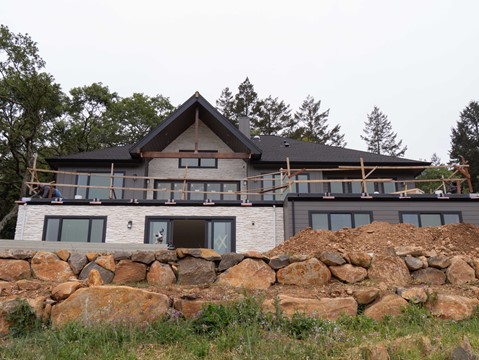
- Products
- Why Nudura
- Nudura Project Applications
- Training Academy
- Resources
- Company
 As a reputable architect or builder, you likely view local building codes as the bare minimum standard. You probably suggest a number of upgrades that will improve comfort, energy efficiency and durability. After a record-setting year for wildfires around the world, from fires in the Canadian north shrouding major cities like New York in an eerie haze to the deadly blazes on the Hawaiian island of Maui, you’re likely fielding a lot of questions about options for fire-proofing a home.
As a reputable architect or builder, you likely view local building codes as the bare minimum standard. You probably suggest a number of upgrades that will improve comfort, energy efficiency and durability. After a record-setting year for wildfires around the world, from fires in the Canadian north shrouding major cities like New York in an eerie haze to the deadly blazes on the Hawaiian island of Maui, you’re likely fielding a lot of questions about options for fire-proofing a home.
If your clients are planning to build in an area at potential risk for future wildfires, here are four areas you should focus on – and encourage your clients to invest in – when planning your build. Each selection can also help the structure withstand other extreme weather events, from rain and hail to ice and snow.
A Solid Footing
Every good house starts with a solid foundation. And there’s no better foundation for building a fire-resistant home than one made with insulated concrete forms, or ICFs. ICF walls can resist fire for three to four times longer than wood-framed walls.
An 8”-thick ICF wall, for example, has a 4-hour fire-resistance rating, compared to a 1-hour rating for a wooden wall. Those extra hours can be the difference between a home that burns to the ground and one that stays standing after a fire has passed.
But ICFs aren’t limited to just foundations. In fact, you can form the exterior walls of an entire home from basement to eaves for top to bottom fire-resistance and durability.
Robust Roofing
A roof takes a beating year-round. Depending on where you are building, it could have to withstand everything from searing summer heat and torrential rains, to hail and heavy winter snow loads. Across most of North America, asphalt shingles are the most popular choice for roofing material in large part because they’re relatively cheap to install. But they don’t stand up to the elements and usually require repairs or complete replacement in 10 to 20 years.
A metal roof, by contrast, is recognized as having among the highest fire-resistance ratings, plus it can withstand the rain, snow and whatever else Mother Nature throws at it. They’re so durable, many brands come with 40- or 50-year warranties. Talk about peace of mind for your clients.
Tile is another durable, fire-resistant option, but you may need to reinforce the roof’s framing to support the additional weight load.
Ironclad Options

 The material chosen for the building’s exterior walls will have a major impact on a home’s fire-resistance. Vinyl siding, for example, is affordable, but it will literally melt if exposed to too much heat.
The material chosen for the building’s exterior walls will have a major impact on a home’s fire-resistance. Vinyl siding, for example, is affordable, but it will literally melt if exposed to too much heat.
Masonry is a great fire-resistant option for exterior cladding that suits both classic and contemporary designs. These timeless options include brick, brick veneer (thin slices of brick), natural stone or manufactured stone.
Another attractive alternative is to use exterior insulation and finish systems, or EIFS, which are a multi-layered solution that includes insulation, an air/weather barrier, and a durable finish. With an array of colors and textures available, this is a versatile façade option for any aesthetic. Some exterior finishes, including Dryvit’s Outsulation lineup, are fire-rated. For this design flexibility and performance over an ICF wall, look to textured acrylic finishes (TAFs).
There are also fire-rated composite siding materials on the market in a variety of colors and styles, including those that mimic traditional shakes or shingles.
If you’re building on a tear-down lot in a dense urban area, the local building code will likely require the use of fire-resistant exterior cladding on walls facing neighboring properties.
Window Wise
Most contemporary designs feature large, floor-to-ceiling windows to maximize the amount of natural light coming in. But those large panes of glass are a weak point in the building’s façade.
Double-glazed windows are standard in new construction. If the outer glass cracks from the heat, the inner layer still provides protection. Top-of-the-line triple-glazed windows add yet another layer of defense and provide the highest energy efficiency ratings. It’s also worth recommending the use of fire-rated exterior doors for all entrances.
It’s almost impossible to build a completely fire-proof home – at least one someone would want to live in. But by choosing the right materials, you can increase the chances that the homes you design and build will survive if a wildfire or nearby residential fire does occur in the area. Talk about leaving a client with a lasting impression! Learn more about how ICFs can help your clients’ homes withstand a whole range of natural hazards here.
CONTACT US
We’re committed to supporting homeowners and design professionals who are interested in or use our products. We’re always happy to help and provide more information.




